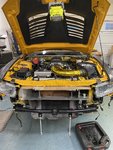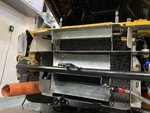↑↑↑ Me too, what was your fix?
- Welcome to the Ford Mustang forum built for owners of the Mustang GT350, BOSS 302, GT500, and all other S550, S197, SN95, Fox Body and older Mustangs set up for open track days, road racing, and/or autocross. Join our forum, interact with others, share your build, and help us strengthen this community!
You are using an out of date browser. It may not display this or other websites correctly.
You should upgrade or use an alternative browser.
You should upgrade or use an alternative browser.
Cooling for warmer climates / race cars
- Thread startercaptdistraction
- Start date
This site may earn a commission from merchant affiliate links, including eBay, Amazon, and others.
More options
Who Replied?- 6,394
- 8,275
More water flow is not necessarily a good idea, more cooling capacity is what is needed. The reason is that water flow that is too fast may not have a chance to get rid of the heat. As an example, if you pull the thermostat out of a car,2 things could happen, 1. the car never gets hot enough and the engine never comes out of cold loop. or, 2. the flow is so fast through the radiator that it constantly overheats.
Those running without thermostats are either managing flow by pully size, or by using some type of restrictor in the thermostat housing.
once you take a heat exchanger, duct it, seal up all the holes in the bodywork with metal tape, do whatever all you can do...then it's all over. once you reach the units capacity for cooling, you are all done, short of using water wetter or some other (not really a bad idea but it's sort of a crutch) coolant scheme, it's time to get a more efficient heat exchanger.
An oil cooler will help, but really, that's an engine lube issue, not an actual coolant problem and should be viewed that way, not as a way to prevent coolant overheat.
Those running without thermostats are either managing flow by pully size, or by using some type of restrictor in the thermostat housing.
once you take a heat exchanger, duct it, seal up all the holes in the bodywork with metal tape, do whatever all you can do...then it's all over. once you reach the units capacity for cooling, you are all done, short of using water wetter or some other (not really a bad idea but it's sort of a crutch) coolant scheme, it's time to get a more efficient heat exchanger.
An oil cooler will help, but really, that's an engine lube issue, not an actual coolant problem and should be viewed that way, not as a way to prevent coolant overheat.
Fabman
Dances with Racecars
- 6,553
- 8,203
- Exp. Type
- W2W Racing
- Exp. Level
- 20+ Years
Exactly. In short track racing we slow the pump via pulleys and put a restriction in the thermostat housing. Water traveling too fast won't transfer heat as effectively and a pump at racing speeds without the head pressure of a slight restriction (or thermostat) will lead to cavitation and almost instant overheating. That's one of the things I like about the electric pumps, a contestant flow rate that doesn't vary by RPM. The size of the restriction in a small block chevy turning 7500 rpm was typically 9/16 to 5/8" so you can see that its not about flowing more water faster, its about effective heat transfer.More water flow is not necessarily a good idea, more cooling capacity is what is needed. The reason is that water flow that is too fast may not have a chance to get rid of the heat. As an example, if you pull the thermostat out of a car,2 things could happen, 1. the car never gets hot enough and the engine never comes out of cold loop. or, 2. the flow is so fast through the radiator that it constantly overheats.
Those running without thermostats are either managing flow by pully size, or by using some type of restrictor in the thermostat housing.
once you take a heat exchanger, duct it, seal up all the holes in the bodywork with metal tape, do whatever all you can do...then it's all over. once you reach the units capacity for cooling, you are all done, short of using water wetter or some other (not really a bad idea but it's sort of a crutch) coolant scheme, it's time to get a more efficient heat exchanger.
An oil cooler will help, but really, that's an engine lube issue, not an actual coolant problem and should be viewed that way, not as a way to prevent coolant overheat.
- 69
- 51
Hi Cap,What S197 came with a factory transmission cooling system when equipped with a manual? I might have missed that boat.
The radiator note was received and not ignored, however the radiator was not the cause of my issues (this car is equipped with a fluidyne piece as very clearly stated in the first post). This one is solved, the car now cools appropriately in even hot temperatures; the fix was discovered and implemented outside this post.
What was the fix? Can you share the link, I've searched and cannot locate it. Thanks!
Fabman
Dances with Racecars
- 6,553
- 8,203
- Exp. Type
- W2W Racing
- Exp. Level
- 20+ Years
Another Trick I used to employ was to put baffles in the aluminum radiators that divert the water across the radiator to make 2 or 3 passes to increase the residence time for enhanced heat transfer. Worked slick.More water flow is not necessarily a good idea, more cooling capacity is what is needed. The reason is that water flow that is too fast may not have a chance to get rid of the heat. As an example, if you pull the thermostat out of a car,2 things could happen, 1. the car never gets hot enough and the engine never comes out of cold loop. or, 2. the flow is so fast through the radiator that it constantly overheats.
Those running without thermostats are either managing flow by pully size, or by using some type of restrictor in the thermostat housing.
once you take a heat exchanger, duct it, seal up all the holes in the bodywork with metal tape, do whatever all you can do...then it's all over. once you reach the units capacity for cooling, you are all done, short of using water wetter or some other (not really a bad idea but it's sort of a crutch) coolant scheme, it's time to get a more efficient heat exchanger.
An oil cooler will help, but really, that's an engine lube issue, not an actual coolant problem and should be viewed that way, not as a way to prevent coolant overheat.
Grant 302
basic and well known psychic
Another Trick I used to employ was to put baffles in the aluminum radiators that divert the water across the radiator to make 2 or 3 passes to increase the residence time for enhanced heat transfer. Worked slick.
That’s what I was suggesting with the better Fluidyne units. There are 2 and 3 pass cites baffled in the tanks. The low end Fluidyne as Chris says is just like the BS Mishimoto unit and essentially made for the street crowd.
The 3 pass units usually retain the OEM hose locations, but the 2 pass and integrated oil to water ones need some custom plumbing to make them work.
More water flow is not necessarily a good idea, more cooling capacity is what is needed.
This is what people reading this thread need to understand. In the context of race cars and high RPM use, even the 948 oil cooler isn’t ‘huge’.
When there is no thermal ‘bridge’ between the oil and coolant systems, the cooling capacity for both need to exceed what is ‘needed’.
Fabman
Dances with Racecars
- 6,553
- 8,203
- Exp. Type
- W2W Racing
- Exp. Level
- 20+ Years
Just for clarification, I see radiators advertised as "3 Pass" when they are actually "3 Row".
A 3 pass radiator is where the water runs across 1/3 of the core, hits a baffle, makes a 180* turn and runs back across the opposite way, hits another baffle in the tank, turns another 180* and on out the bottom.
A "3 Row" radiator has 3 rows of tubes running across from tank to tank as viewed from the top, but goes through the radiator only once.
Most all of the after market radiators I have seen are "3 Row" but not "3 Pass".
A 3 pass radiator is where the water runs across 1/3 of the core, hits a baffle, makes a 180* turn and runs back across the opposite way, hits another baffle in the tank, turns another 180* and on out the bottom.
A "3 Row" radiator has 3 rows of tubes running across from tank to tank as viewed from the top, but goes through the radiator only once.
Most all of the after market radiators I have seen are "3 Row" but not "3 Pass".
Fabman
Dances with Racecars
- 6,553
- 8,203
- Exp. Type
- W2W Racing
- Exp. Level
- 20+ Years
My personal stock car had the water enter the bottom of the radiator and out the top.
I had no radiator cap, just a tube out the top of the tank that ran back to the degas bottle to constantly bleed air from the system.
There was also one from the top of the thermostat housing. It was a bulletproof system.
I had no radiator cap, just a tube out the top of the tank that ran back to the degas bottle to constantly bleed air from the system.
There was also one from the top of the thermostat housing. It was a bulletproof system.
Grant 302
basic and well known psychic
Understood. The higher end Fluidyne models are like that. 2 and 3 pass like I said with baffles in the end tanks. It was clear when we saw them on the CVR school cars.Just for clarification, I see radiators advertised as "3 Pass" when they are actually "3 Row".
A 3 pass radiator is where the water runs across 1/3 of the core, hits a baffle, makes a 180* turn and runs back across the opposite way, hits another baffle in the tank, turns another 180* and on out the bottom.
A "3 Row" radiator has 3 rows of tubes running across from tank to tank as viewed from the top, but goes through the radiator only once.
Most all of the after market radiators I have seen are "3 Row" but not "3 Pass".
Fabman
Dances with Racecars
- 6,553
- 8,203
- Exp. Type
- W2W Racing
- Exp. Level
- 20+ Years
When I ordered mine it was called out as a 3 pass which is why I chose that model.Understood. The higher end Fluidyne models are like that. 2 and 3 pass like I said with baffles in the end tanks. It was clear when we saw them on the CVR school cars.
Kenny Brown had it on his website labeled as a 3 pass, made a big deal about how special it was in the add so I ordered it, but was disappointed when it arrived to see that it was actually only a common 3 row-single pass. Marketing-Pffft.
I'm not sure what one has to do at this point to make sure you are getting what you think you are getting other than look at the price or have the part in your hand.
Grant 302
basic and well known psychic
That is a common problem with website descriptions and pictures. As you say price is a good hint.When I ordered mine it was called out as a 3 pass which is why I chose that model.
Kenny Brown had it on his website labeled as a 3 pass, made a big deal about how special it was in the add so I ordered it, but was disappointed when it arrived to see that it was actually only a common 3 row-single pass. Marketing-Pffft.
I'm not sure what one has to do at this point to make sure you are getting what you think you are getting other than look at the price or have the part in your hand.
Fabman
Dances with Racecars
- 6,553
- 8,203
- Exp. Type
- W2W Racing
- Exp. Level
- 20+ Years
I checked his site and as of today it indeed calls it out as a 3 row and 3 pass and the picture shows a 3 pass so hopefully that's what customers are getting.That is a common problem with website descriptions and pictures. As you say price is a good hint.
Grant 302
basic and well known psychic
Yes, they used to sell at least two types, maybe 3 at some point for S197. Single pass, double pass with the oil cooler and triple pass.I checked his site and as of today it indeed calls it out as a 3 row and 3 pass and the picture shows a 3 pass so hopefully that's what customers are getting.
The note by Fabman is is right on, that the reason behind restrictors and/or pulleys is to avoid pump cavitation that can occur at high speeds. This is even more of a problem with the inexpensive, stamped vane type impellers in the older water pumps that were even more prone to cavitation and inefficient. As blacksheep points out getting the air flow maximized thru sealing and ducting gets the most from the radiator. As other pointed out, getting the temperature out of the engine bay with a vented hood does help and did help in my case. I do not disagree that the improvement of higher flow may not yield a big change in temperatures since the radiator thermal conductivity efficiency curve improvements slope slows (As a reference of a heat exchanger curve see the Setrab curve linked below), but higher flow (besides cavitation) in a closed system such as automotive will have no negative effect and only a possible improvement. Here is an excerpt from the tech areas supporting this statement and the links below to Stewart Components which does a good job explaining and also were the original rules of thumb were born (the second link is to the tech articles). There are additional SAE articles out there, but much more mind numbing to find the information.
Stewart components excerpt:
"ADVANCED COOLING SYSTEM BASICS
Common Misconceptions
 shop.championcooling.com
shop.championcooling.com
Stewart components excerpt:
"ADVANCED COOLING SYSTEM BASICS
Common Misconceptions
- Coolant temperatures are not an accurate indicator of metal temperatures. The coolant's maximum temperature is it's pressure corrected vapor point. The metal can be several hundred degrees hotter than the adjacent coolant.
- Temperatures of critical areas must be determined by checking the metal at a controlled distance from the combustion chamber surface. This eliminates discrepancies caused by the variances in metal thicknesses.
- Higher coolant flow will ALWAYS result in higher heat transfer. Coolant cannot absorb heat after it reaches it's pressure corrected vapor point. Furthermore, coolant absorbs heat at a progressively slower rate as it approaches this point"
Will A High Flow Water Pump Keep Me From Overheating?
 shop.championcooling.com
shop.championcooling.com- Thread starter
- #55
captdistraction
GrumpyRacer
The fix had nothing to do with the cheap radiators (read: consumables) I run.
The issue was all within the management of air flowing through them. By having the boxed solution for the radiator and some of the oil cooler, but leaving the majority of the oil cooler floating 2" in front of the radiator, I believe a large portion of the pressure differential across the sides of the core was stalled. By revising the box to box the oil cooler TO the radiator front face, I was able to create the pressure differential needed to improve cooling. I also went to a lower thermostat (I don't believe this had any real effect as the other thermostat was brand new, 160 vs 180), stayed with the mechanical pump and ran the mishimoto radiator for both tests
This is the closest apples to apples comparison I can make. Lap 3 from track A with the old setup (mech pump, floating oil cooler core, mishimoto radiator, 180 thermostat)

Lap 7 (due to shorter distance to match distance traveled and try to keep the IAT's close for comparison's sake) Track B (same as before, revised ducting, 160* stat)

Average speeds, RPMs, and other heat related categories were similar, both were very hot days in the 90*s in Arizona. I could go buy fancy radiators costing up to $1000, but at this point I believe that would be diminishing returns and am happy with where the car is at, and confident in being able to complete a 30 minute race in these conditions (assuming non-sound restricted track - as that's also a factor. I won't run those anymore as its not worth the wear on the car).
The issue was all within the management of air flowing through them. By having the boxed solution for the radiator and some of the oil cooler, but leaving the majority of the oil cooler floating 2" in front of the radiator, I believe a large portion of the pressure differential across the sides of the core was stalled. By revising the box to box the oil cooler TO the radiator front face, I was able to create the pressure differential needed to improve cooling. I also went to a lower thermostat (I don't believe this had any real effect as the other thermostat was brand new, 160 vs 180), stayed with the mechanical pump and ran the mishimoto radiator for both tests
This is the closest apples to apples comparison I can make. Lap 3 from track A with the old setup (mech pump, floating oil cooler core, mishimoto radiator, 180 thermostat)

Lap 7 (due to shorter distance to match distance traveled and try to keep the IAT's close for comparison's sake) Track B (same as before, revised ducting, 160* stat)

Average speeds, RPMs, and other heat related categories were similar, both were very hot days in the 90*s in Arizona. I could go buy fancy radiators costing up to $1000, but at this point I believe that would be diminishing returns and am happy with where the car is at, and confident in being able to complete a 30 minute race in these conditions (assuming non-sound restricted track - as that's also a factor. I won't run those anymore as its not worth the wear on the car).
- Thread starter
- #56
captdistraction
GrumpyRacer
Before:

After: (though ignore the loose pieces of foam wedged in there, I was waiting on more edge trim and did not take additional pictures after placing it)

You can see the additional baffling and diverting I did to pick up air and control the path it takes through the cores. What's missing from the before picture is the top of the top cavity is the exposed upper radiator support. In the bottom you can see the diverter panel to block that off fully as well.

After: (though ignore the loose pieces of foam wedged in there, I was waiting on more edge trim and did not take additional pictures after placing it)

You can see the additional baffling and diverting I did to pick up air and control the path it takes through the cores. What's missing from the before picture is the top of the top cavity is the exposed upper radiator support. In the bottom you can see the diverter panel to block that off fully as well.
Fabman
Dances with Racecars
- 6,553
- 8,203
- Exp. Type
- W2W Racing
- Exp. Level
- 20+ Years
Taking notes here as I am about to embark on exactly this journey...something I missed is what did you mount the bottom of the oil cooler too?Before:
View attachment 55741
After: (though ignore the loose pieces of foam wedged in there, I was waiting on more edge trim and did not take additional pictures after placing it)
View attachment 55740
You can see the additional baffling and diverting I did to pick up air and control the path it takes through the cores. What's missing from the before picture is the top of the top cavity is the exposed upper radiator support. In the bottom you can see the diverter panel to block that off fully as well.
- Thread starter
- #58
captdistraction
GrumpyRacer
The box itself, which is mounted to the lower condenser pickups on the radiator, the whole thing is very stable and allows for some vibration damping in silicone mounting pads.
Fabman
Dances with Racecars
- 6,553
- 8,203
- Exp. Type
- W2W Racing
- Exp. Level
- 20+ Years
Yes, my duct mounts to those bosses too, just was a little uneasy about adding the weight of the cooler to them as well. I wondered how you had handled that. Thanks.The box itself, which is mounted to the lower condenser pickups on the radiator, the whole thing is very stable and allows for some vibration damping in silicone mounting pads.
- Thread starter
- #60
captdistraction
GrumpyRacer
since the cooler is primarily bolted to the upper radiator support, the front condensor support bosses on the radiator are really holding no more weight than they were when they held the condensor, I'd argue likely less since its more holding the frame and cooler assembly against the radiator than supporting it (since both sub assemblies are primarily mounted to the upper radiator support - there's a total of 8 vertical bolt locations - 4 for the cooler mount, 4 for the upper box/frame mounts)













